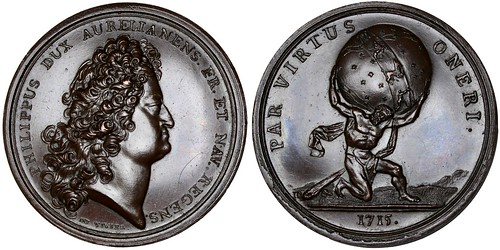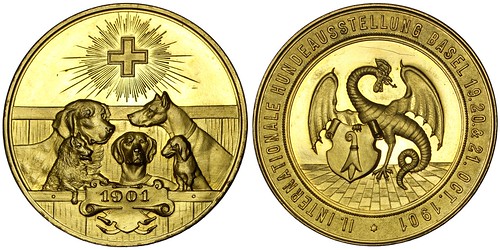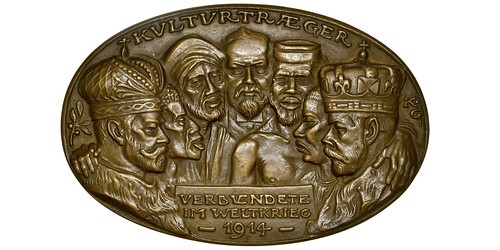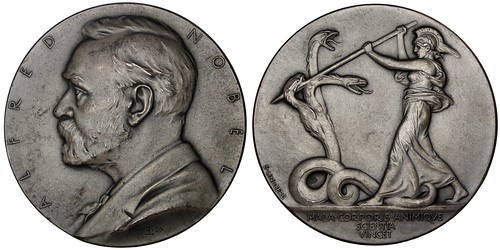
PREV ARTICLE
NEXT ARTICLE
FULL ISSUE
PREV FULL ISSUE
NUMISMAGRAM MEDAL SELECTIONS: JUNE 18, 2023Numismagram's Jeremy Bostwick sent along these four highlights from his most recent addition of new material. For all of this upload's new additions, please visit https://www.numismagram.com/inventory -Editor 102426 | FRANCE. Philippe II, Duke of Orléans bronze Medal. Dated 1715 (though likely issued circa late 18th century). Commemorating the beginning of the Duke's regency for King Louis XV (41mm, 40.65 g, 12h). By J. Duvivier & J. Dollin at the Paris mint. PHILIPPUS DUX AVRELIANENS FR ET NAV REGENS, bare head right // PAR VIRTVS ONERI (the strength shall meet the burden), Atlas right, bent to one knee, bearing celestial sphere (with zodiacal band separating the stars) upon his back. Edge: Plain. Divo 6. Choice Mint State. Deep brown surfaces, with some light rub upon the highest points and some brilliance in the fields. $295. Upon the death of the "Sun King" (Louis XIV), the throne passed to Louis XV, the great-grandson of the former. However, at the time, the younger Louis was not yet 6 years old. As such, in keeping with custom, a regent was appointed to effectively rule in the place of the boy-king until he reached his majority, which was the age of 13. Philippe II, the Duke of Orléans, thus served as the Regent of France from 1715 until the 13th birthday of Louis XV on 15 February 1723. On this medal, the weighty role as chief decision maker in the kingdom is expressed through Atlas bearing the celestial sphere upon his back.
To read the complete lot description, see:
SWITZERLAND. Basel. Dog Show gilt bronze Award Medal. Issued 1901 for the 2nd International Dog Exposition from 19–21 October (45mm, 40.44 g, 12h). Five different hounds below radiant Swiss cross; 1901 on garnished cartouche below // II. INTERNATIONALE HUNDEAUSSTELLUNG BASEL 19. 20. & 21. OCT. 1901, basilisk left, head right, holding garnished coat-of-arms of Basel. Edge: Plain. Choice Mint State. A few light marks, one of which occurs above the head and left wing of the basilisk; otherwise highly brilliant and prooflike. $195. Despite sometimes being referred to as a dragon, the mythical creature on the reverse of this medal (along with many of Basel's coins) is that of a basilisk. The origin of such mythical creatures is from ancient Greece, with it said to have had the head of a rooster and wearing a crown, all with the body of a serpent. By medieval times, this iconography had changed somewhat to having a body more akin to that of a wyvern, with the basilisk and the cockatrice essentially being the same. What remained throughout lore was the fact that the gaze of the basilisk, just like Medusa, was said to be lethal. It is not fully certain as to why the basilisk became symbolic with Basel, whose name in Roman times was Basilea, though the punning nature of the city's name and the mythical creature is quite likely.
To read the complete lot description, see:
GERMANY & ENTENTE POWERS. Carriers of Culture cast bronze oval Medal. Dated 1914. "Kulturträger–Die Verbündeten im Weltkrieg"—on the allies' use of native colonials (90mm x 58mm, 12h). By K. Goetz in München. KVLTVRTRÆGER, crowned and mantled busts of Nikolai II of Russia right and George V of the United Kingdom left; between them, facing bust of Raymond Poincaré (President of France), with hands on the monarchs' shoulders; in between (from left to right), busts with heavily caricatured features of African, Central Asian, Indonesian, and Asian soldiers, all held together Poincaré's "group hug" embrace; in two lines in exergue, VERBVENDETE / IM WELTKRIEG // ZVR SCHANDE / SEI ES LAVT GESAGT, / ZVM SPOTTE – / ER WIRD IN EVCH NAGEN, / DASS IHR DIE WILDEN HORDEN / JAGT AVF JENE – / DIE, KVLTVR NACH FERNSTEN / LANDEN TRAGEN (Let it be said out loud in derision, "For Shame"– It will gnaw on you that for you the wild hordes hunt on those who carry culture to the furthest lands) in eight lines. Kienast 140. NGC MS-62 Brown. $645. Here, Goetz very directly alludes to allied use of colonial soldiers in the war effort. While sticking to rather benign, non-caricatured depictions of the three leaders, he heavily delves into racialized tropes with the non-Caucasian representations. This visual stereotyping is present in a contemporaneous issue satirizing Japan in Germany's colonial outpost in Chinese Kiao Chau (Jiaozhou), and later during post-WWI issues pertaining to the occupation of the Rhineland and the supposed harassment of German women by French colonial troops from Africa. A larger issue than those generally issued by Goetz at the time, and in the highly unusual oval (rather than circular) format.
To read the complete lot description, see:
SWEDEN. Alfred Nobel silver Medal Issued 1926. Commemorating the 30th anniversary of his death (45mm, 45.72 g, 12h). By E. Lindberg for the Swedish Academy of Sciences. ALFRED NOBEL, bust left in frock coat // Pallas-Athena standing left, spearing tri-headed serpentine Hydra to left; in three lines in exergue, MALA • CORPORIS • ANIMIQVE / SCIENTIA / VINCET (may knowledge conquer the maladies of both mind and body). Edge: SILVER 1926. Ehrensvärd 268. Mint State. Light graphite gray hues, with a tremendous matte nature to the surfaces. A very rare and desirable issue paralleling the Nobel nominating committee medals, which were also done by Erik Lindberg. From a mintage of just 150 examples. $1,095. Known for inventing dynamite and bequeathing his fortune in order to fund what would become the Nobel Prizes, Alfred Nobel was a prolific inventor who held over 350 patents. In 1864, he founded the Nitroglycerin Aktiebolaget (Nitroglycerin Corporation), the world's first manufacturer of nitroglycerin (which was vital in his patenting of dynamite a few years later). As for the artist of this medal, Erik Lindberg was tasked early on with the creation of the Nobel Prize medals in 1901—the Nobel institution for the awarding of these prizes having been newly established. Outside of the Peace Prize (presented instead in Oslo) and the Economics Prize (created much later by the Sveriges Riksbank and not considered part of the Nobel canon), Lindberg's renditions continue to be used for the prize medals to this day, as well as the medals presented to the respective nominating committees. This medal, with its very small mintage of just 150 examples, comes in a larger format of 45mm (rather than 26mm for the nominating committee medals, which continue to be made and awarded). The bust style is also slightly modified from that of the nominating committee medals, and it features a reverse with the same Neoclassical flair as the Nobel Prize medals themselves.
To read the complete lot description, see:
Wayne Homren, Editor The Numismatic Bibliomania Society is a non-profit organization promoting numismatic literature. See our web site at coinbooks.org. To submit items for publication in The E-Sylum, write to the Editor at this address: whomren@gmail.com To subscribe go to: https://my.binhost.com/lists/listinfo/esylum All Rights Reserved. NBS Home Page Contact the NBS webmaster 
|




